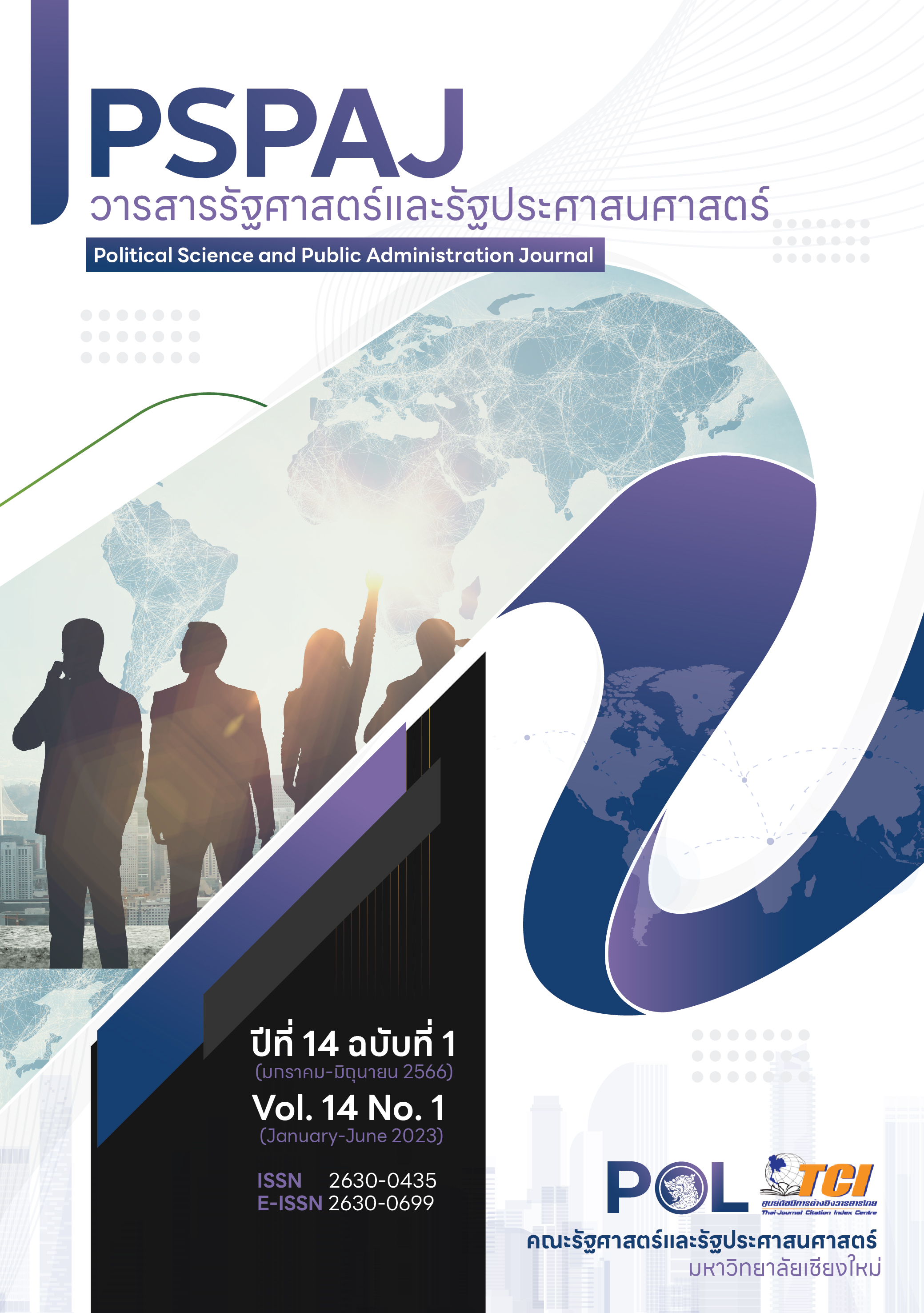Integrated Water Resource Management by A Governmental Organization: A Case Study Lam Takhong Basin, Nokhon Ratchasima
Main Article Content
Abstract
“Water” is important for people’s living and national development. Water resources at present, however, are facing a great number of increasingly severe problems. Management of water resources is thus very important. This research was aimed at studying the Integrated water resource management by a governmental organization, and at recommending a developmental model for Integrated water resource management by a governmental organization. The qualitative research method was used and the data was collected by group interviews and in-depth interviews, conducted with the personnel responsible for water resource management from 5 local administrative organizations, the personnel in charge of 8 spillways, and 11 leaders of irrigation water user groups at the Water Distribution and Maintenance Areas 1-4. The data was collected from March, 2018 until November, 2018, and was analyzed and presented by the Descriptive Analysis Method. The research results demonstrate the following: 1) The integrated water resource management by governmental organizations involve the environmental condition that eases the management, namely, the policy related to water resource management and the strategy for area-based water resource management; the institutional roles, namely, integration of work, coordination, and the framework of power and duty in coordination; and the management tools, namely, increase of communication channels and provision of a stage for learning and sharing of water resource management. 2) The developmental model for integrated water resource management by a governmental organization, includes: the evaluation of water resource management, the strategic planning for water resource management, placing importance on irrigation water users, development of irrigation water users’ potential, building and maintaining the working environment, and placing the importance on water resource management outcomes.
Article Details

This work is licensed under a Creative Commons Attribution-NonCommercial-NoDerivatives 4.0 International License.
- เนื้อหาและข้อมูลที่ลงตีพิมพ์ในวารสารรัฐศาสตร์และรัฐประศาสนศาสตร์ถือเป็นข้อคิดเห็นและความรับผิดชอบของผู้เขียนบทความโดยตรง ซึ่งกองบรรณาธิการวารสารรัฐศาสตร์และรัฐประศาสนศาสตร์ ไม่จำเป็นต้องเห็นด้วย หรือร่วมรับผิดชอบใดๆ
- บทความและข้อมูล ที่ได้รับการตีพิมพ์ในวารสารรัฐศาสตร์และรัฐประศาสนศาสตร์ ถือเป็นลิขสิทธิ์ของวารสาร หากบุคคลหรือหน่วยงานใดต้องการนำข้อมูลไปใช้ประโยชน์ในทางวิชาการ ขอให้อ้างอิงแหล่งที่มาด้วย
References
โครงการส่งน้ำและบำรุงรักษาลำตะคอง. (2562). ข้อมูลการปกครองในเขตลุ่มน้ำลำตะคอง. นครราชสีมา: สำนักงานชลประทานที่ 8.
สัจจา บรรจงศิริ, ดุสิต เวชกิจ, บำเพ็ญ เขียวหวาน, และปาลีรัตน์ การดี. (2553). การศึกษาวิจัยการบริหารจัดการทรัพยากรน้ำแบบผสมผสาน (IWRM) ของประเทศและการผลักดันสู่การปฏิบัติ: กรณีศึกษาพื้นที่ลุ่มน้ำแม่กลอง. กรุงเทพฯ: กรมทรัพยากรน้ำ กระทรวงทรัพยากรธรรมชาติและสิ่งแวดล้อม.
สำนักงานทรัพยากรน้ำภาค 5. (2553). ยุทธศาสตร์การบริหารจัดการทรัพยากรน้ำและลุ่มน้ำลำตะคองแบบบูรณาการ. นครราชสีมา: สำนักงานทรัพยากรน้ำภาค 5.
Aung, T. (2021). Evaluation of Integrated Water Resources Management (IWRM) in Myanmar. Retrieved June 13, 2022, from https://www.researchgate.net/publication/353548753
Bateman, B., & Rancier, R. (2012). Case Studies in Integrated Water Resources Management: From Local Stewardship to National Vision. Virginia: American Water Resources Association, Policy Committee.
Bokal, S., Grobicki, A., Kindler, J., & Thalmeinerova, D. (2014). From National to Regional Plans – The Integrated Drought Management Programme of the Global Water Partnership for Central and Eastern Europe. Weather and Climate Extremes, 3, 37-46. Retrieved July 25, 2022, from https://doi.org/10.1016/j.wace.2014.03.006
Global Water Partnership and The International Network of Basin Organization. (2009). A Handbook for Integrated Water Resources Management. Sweden: Elanders.
Kumar, P., Liu, W., Chu, X., Zhang, Y., & Zhihui, L. (2019). Integrated Water Resources Management for an Inland River Basin in China. Watershed Ecology and the Environment, 1, 33-38. Retrieved June 13, 2022, from https://www.sciencedirect.com/science/article/pii/S2589471419300026
Myrzahmetov, M., Umbetova, S. M., Ashiryayev, K. S., Kozhakhan, A. K., & Kanarbay, A. U. (2018). On the Strategy of Integrated Water Resources Management in Kazakhstan. Journal of Environmental Management & Tourism, 9(8(32)), 1821-1826. Retrieved June 13, 2022, from https://www.proquest.com/docview/2434406402?pq-origsite=gscholar&fromopenview=true
Popovici, R., Ma, Z., Erwin, A. E., Prokopy, L. S., Velarde, C. R. Z., Delgado, E. F. B., & Cáceres, J. P. P. (2022). Maladaptive Learning in Peru’s Integrated Water Resources Management. Environmental Science & Policy, 127(3), 209-217. Retrieved June 13, 2022, from https://www.researchgate.net/publication/355925346_Maladaptive_learning_in_Peru's_integrated_water_resources_management
Roestamy, M., & Fulazzaky, A. M. (2021). A Review of the Water Resources Management for the Brantas River Basin: Challenges in the Transition to an Integrated Water Resources Management. Environment, Development and Sustainability, 24, 11514–11529. Retrieved June 13, 2022, from https://link.springer.com/article/10.1007/s10668-021-01933-9
Van der Zaag, P. (2005). Integrated Water Resources Management: Relevant Concept or Irrelevant Buzzword? A Capacity Building and Research Agenda for Southern Africa. Physics and Chemistry of the Earth, Parts A/B/C, 30(11-16), 867-871. Retrieved July 25, 2022, from https://doi.org/10.1016/j.pce.2005.08.032
Viessman, W. (1998). Water Policies for the Future: Bringing It All Together. Water Resources Update, (111), 104-110.
Wang, K., Davies, E., & Liu, J. (2019). Integrated Water Resources Management and Modeling: A Case Study of Bow River Basin, Canada. Journal of Cleaner Production, 240, 118242. Retrieved June 13, 2022, from https://www.researchgate.net/publication/335500637


